#government schemes for agriculture
Video
youtube
Government Agriculture Schemes & Subsidies | Farmer Subsidy Scheme | किसानों के लिए सरकारी योजना
#youtube#agriculture subsidy#subsidy scheme#uttar pradesh government schemes 2022#government schemes for agriculture#Farmer Subsidy Scheme#farmer scheme in uttar pradesh#farmer scheme in hindi#schemes for farmers
0 notes
Text
12 hour shifts should be illegal. Holy hell.
#venting. Feel free to scroll past#so tired of being stuck in a hole of a town#you try to look for a job and it's like hey! your options are: 10 jobs where there's never enough people working and you have to do#5 tasks at once or 3 jobs where you slave your entire day away in a factory with hypersurveillance and no social interaction#and hey haha maybe you'll get a break?? It's totally not guaranteed in your first 10 options hahaha#FUCK#the nearest marginally okay job is an hour away#gas cost is up the fuckin roof#but hey! there's ways of getting around earning money. You could buy something and make other people's lives more miserable by letting them#borrow it and holding power over them because there's no place to escape to except for another person who owns their shit :)#LIKE YOUR FUCKING HOUSE#AND YOUR CAR#AND THE MONEY YOU SAVE FOR YOUR HEALTH AND YOUR CAR THAT YOU'RE NOT EVEN ALLOWED TO USE MOST OF THE TIME#GOD KNOWS I CANT FIX MY GODDAMN TEETH#you could join the shitshow that is online investing- sorry i mean advanced pyramid scheming with a little bit of actual stake in the world#please. please oh my god#the only way to make things even a little easier is to live in a housefull of 5-6 working people but god. At least kids don't have to#work anymore because of government assistance. But once you're an adult with anything a tad over minimum wage? You're on your own buddy#Life was never supposed to be about living hand to mouth. We surpassed that way of living as soon as agriculture became a thing.#automation. surplus. the ability to relax can be mass produced.#please. i just want a job to support the few people i have without turning into some stressed asshole that either sleeps or rages at them
2 notes
·
View notes
Text
1 note
·
View note
Text

Crop Protection Made Easy with Pradhan Mantri Fasal Bima Yojana
Discover the simplicity of crop protection with the Pradhan Mantri Fasal Bima Yojana (PMFBY), a flagship initiative by the Department of Agriculture, Cooperation and Farmers’ Welfare. Under the National Agricultural Insurance Scheme, the scheme ensures seamless coverage for farmers nationwide, adhering to the principle of "One Nation, One Crop, One Premium." This innovative PMFBY Scheme safeguards farmers against unpredictable crop losses, providing financial security and promoting sustainable agriculture. Explore the user-friendly features and comprehensive benefits of the PM Fasal Bima Yojana to make informed decisions for a resilient farming future. Embrace the ease of crop protection with the Pradhan Mantri Fasal Bima Yojana today.
#pradhan mantri fasal bima yojana#PMFBY scheme#PMFBY#PM Fasal Bima Yojana#National Agricultural Insurance Scheme#government scheme
0 notes
Text
Pm Kisan 4 Lakh Beneficiary Farmers Of Haryana Did Not Get Land Verification Done
Pm Kisan 4 Lakh Beneficiary Farmers Of Haryana Did Not Get Land Verification Done
PM Kisan Land Verification: प्रधानमंत्री किसान सम्मान निधि योजना में बढ़ते गैर-कानूनी मामलों के बाद सरकार ने ई-केवाईसी और लैंड रिकॉर्ड्स का वेरिफिकेशन अनिवार्य कर दिया है. कई किसानों ने ये दोनों ही काम नहीं है, जिसकी वजह से 12वीं किस्त रोक दी गई है और अब 13वीं किस्त तक भी वेरिफिकेशन नहीं करवाया तो सरकार अयोग्य घोषित कर सकती है. हाल ही में हरियाणा के 3 लाख 36 हजार 306 किसानों की पहचान हुई है, जो…
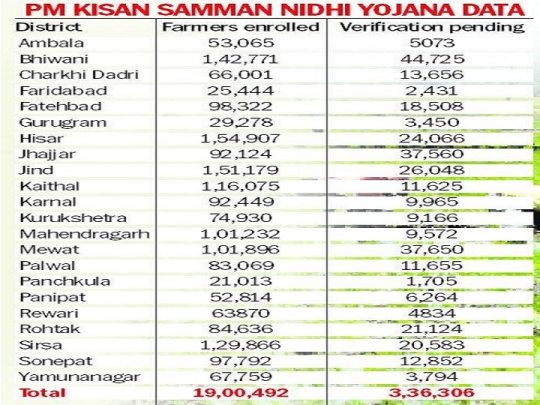
View On WordPress
#Agriculture News#Agriculture Scheme#Government SCheme#pm Kisan#PM Kisan 13th installment#pm kisan ekyc#PM Kisan Haryana Farmers#PM Kisan Land Verification#PM Kisan Samman Nidhi Yojana#PM Kisan Scheme#PM Kisan Yojana#कृषि योजना#कृषि समाचार#पीएम किसान#पीएम किसान 13वीं किस्त#पीएम किसान एक्वायसी#पीएम किसान भूमि सत्यापन#पीएम किसान योजना#पीएम किसान सम्मान निधि योजना#पीएम किसान हरियाणा किसान#सरकारी योजना
0 notes
Text
राजस्थान के आधे किसानों को कैसे फ्री मिल रही है बिजली? सरकार ने विधानसभा में दिया ब्यौरा
राजस्थान के आधे किसानों को कैसे फ्री मिल रही है बिजली? सरकार ने विधानसभा में दिया ब्यौरा
मुख्यमंत्री किसान मित्र ऊर्जा योजना के तहत किसानों को बिजली बिल में हर महीने दी जा रही है 1000 रुपये की छूट. बिजली बिल में दी गई 1324 करोड़ रुपये की सब्सिडी. सरकार ने विधानसभा में दी जानकारी.
राजस्थान के किसानों को राहत.
Image Credit source: File Photo
राजस्थान के ऊर्जा राज्य मंत्री भंवर सिंह भाटी ने दावा किया है कि प्रदेश के 12 लाख 76 हजार कृषि उपभोक्ताओं को बिजली बिलों में 1,324 करोड़ रुपये की…

View On WordPress
0 notes
Text
किसानो की बल्ले बल्ले: धान की जगह दूसरी फसल उगाओ, 7000 रूपए प्रति एकड पाओ
किसानो की बल्ले बल्ले: धान की जगह दूसरी फसल उगाओ, 7000 रूपए प्रति एकड पाओ
हरियाण: खरीफ फसलों की सिंचाई समस्या से किसानों को राहत देने के लिए केंद्र और राज्य सरकारें अपने-अपने स्तर पर विभिन्न योजनाएं चला रही हैं। इसी क्रम में हरियाणा सरकार ने राज्य के किसानों को लाभ पहुंचाने के लिए मेरा पानी मेरी विरासत योजना शुरू की है। इस योजना के तहत राज्य के किसानों को धान की खेती छोड़ने पर सब्सिडी दी जा रही है।
हरियाणा सरकार ने ट्वीट कर जानकारी दी है कि सरकार गिरते भूजल और पानी के…

View On WordPress
#Agriculture news#Kisan news#Government committed to conserve falling groundwater and water#HARYANA NEWS#HINDI NEWS#the central and state governments are running various schemes at their respective levels.#To give relief to the farmers
0 notes
Text
No. Nope.
Using language that systems may also use in a medical setting to describe their expereinces and go through treatment is not appropriation. Full stop.
There is no culture being exploited, unless you want to argue that the medical-industrial complex is a closed culture somehow.
Which I have definitely seen posts saying something dangerously close to this, and I urge you to not base your entire sense of self on the guys making money off of you. Even if they're helping, there's intentional siphoning of money from poor patients.
Secondly, language is a tool used to communicate. Words exist as "bodies" to a concept, and sometimes this concept is interpreted a little differently from person to person. There are a lot of words that mean several different things depending on the context. The most important thing is the setting which they're used in. A good ammount of medical terms are also words that are used by laymen in other contexts, meaning something different.
A system is a group of interrelated parts working together as a whole.
An Operating System (OS) is a system of code and software that tells the hardware what to do in order to make your computer run. There's agricultural systems, government systems, the solar system itself. Are these things appropriating the medical-industrial complex by existing as parts that make one whole thing work?
And before anyone splits hairs about this, I am not equating human life to computers or the government. These are examples of things that are literally defined AS SYSTEMS. The main takeaway you should be having here is that system is a broad term with many many applications outside of the medical-industrial complex. That one institution does not own the word nor the concept of being multiple parts (headmates/alters/whatever) working together.
The concept still exists and system still is a word outside of a medical context.
In other words, people would have eventually came to the conclusion of calling themselves systems regardless of if it was used in a medical context or not. It's not hard to put 2 and 2 together, to see parallels in concepts and expereinces and decide those words work just fine. Thank you for coming to my TEDtalk.
This is a post online, made by a trauma-formed system. I'm not going to have the time and foresight to cover every little nuance, and I don't care to be pedantic and pick apart small case instances. At the end of the day, this does not actually matter to how I live my life, how I get therapy, how we as a system have to work together. Endos using terms that are also used in a medical setting (but also used outside of medical settings) is not harmful to me in any way. And quite frankly, I think anti-endo witchunting has done more damage to us as a system trying to figure out how to navigate life than any endo friendly post has. I'm not arguing semantics, I'm going to go live my life and go outside and do my job and pay my bills like everyone else.
All this discourse around stealing terms and what you can and can't call yourself is so seriously unimportant in the grand scheme of things. You all sound so comfy and privileged to be worried about something so trivial as a word or three that is used in multiple contexts accross human language.
#syscourse#<- once again tagging bc yall need to see this and read it and really get it into your heads#im tired of boring terminology “”debates“”#theres no debate language exists and people use it too bad so sad#theres more important things to talk about#LIKE THE EXPLOITATION OF THE VULNERABLE IN THE MEDICAL INDUSTRIAL COMPLEX MAYBE ?????
82 notes
·
View notes
Note
In a world where Robb Stark wins his war and manages to consolidate his realm, with the 7K being no more, lets assume he also annexes the northern crownlands too, what kind of council or burocracy would he establish to govern and how much of your economic development plans could he reasonably carry out in his lifetime and how could he unify his 2 realms economy into a cohesive unit?
In a Stark victory scenario, I think annexing the northern Crownlands would be an overstretch and something of a distraction from more important tasks (like bringing the Iron Islands and the Vale into his sphere of influence so that he can govern a geographically, economically, and politically coherent kingdom/coalition of northern Westeros).
To quote King Robb:
"Duskendale, on the narrow sea? Why would they go to Duskendale?" He'd shook his head, bewildered. "A third of my foot, lost for Duskendale?"
What matters in a brand-new Kingdom of the North is things like whether Gulltown accepts silver coins minted in White Harbor with Robb's face on them as valid payment for debts and taxes, or whether the Ironborn agree to keep their reaving south of Ironman's Bay, or whether the Stark navy can keep the Trident open all the way to the Bay of Crabs so that the Riverlands can keep trading directly with Braavos.
I did some back-reading through various economic development posts to see what I'd said in the past about the tricky scenario of how one balances the interests of multiple kingdoms in pursuing economic development. One of the things I'm noticing is that there are some reforms where there is real issues with competition/duplication of efforts (a Kingdom of the North can probably only support one Bank, one canal scheme, one sub-treasury system, one purchasing/marketing cooperative, etc.), some reforms where individual kingdoms can pursue their own goals but where there would be an issue about how the king balances the rewards he's doling out between the kingdoms (do you put your marginal dragon into winter schools and greenhouses for the North or church schools for the Riverlands or roads for the Vale?), and some where every kingdom can pitch in in a common effort (if there's going to be one sub-treasury plan, you're going to need a network of granaries along waterways from the Last River down to the Trident, the same information about how to improve agricultural productivity can be shared between the North, the Riverlands, and the Vale basically for free, etc).
That being said, one of the major political challenges of the Kingdom of the North was always going to be how you balance the interests of the component kingdoms and make everyone feel like the central government is giving them a fair deal and being attentive to their interests - and as you say, forging them into a cohesive economy would go a long way into doing that. So for example, one priority should be in working out reciprocity in trade between the newly-chartered cities. It certainly helps that a bunch of them (White Harbor, Gulltown, Maidenpool, Lord Harroway's Town, Saltpans) are along the same coast of the Narrow Sea or just upriver from the Narrow Sea, which makes close trade links more likely. However, you're going to want to make formal legal arrangements that, when it comes to port fees and staple fees and warehousing fees and the like, all of the North's cities agree to set them as low as possible for other Northern cities (if not an outright zollverein), and that burgher rights are transferrable between cities and that city ordinances will be honored by other cities, and so on.
In terms of "council or burocracy would he establish to govern," Robb was already taking a decent first step to bolster Lord Paramount Edmure Tully by appointing Brynden the Blackfish as Warden of the Southern Marches.
As I've written before, issuing city charters would be a crucial element of governing the Riverlands effectively. Giving Maidenpool, Lord Harroway's Town, Stoney Sept, Fairmarket, and Seagard a combination of economic and political self-governance would paradoxically allow King Robb to project royal authority more effectively - especially when it comes to generating revenue and manpower and enforcement of economic regulations.
#asoiaf#asoiaf meta#westerosi economic development#war of five kings#kingdom of the north#the north#the riverlands#the vale#iron islands#robb stark
121 notes
·
View notes
Text
The link between warfare and technological innovation has been well documented [...]. World War II was a particularly intense crucible of technological change, and the repurposing of military technologies and industries in the forging of a new post-war consumer [economy] is crucial [...]. Processes of technological bricolage turned the machines of war onto the natural world as global powers competed to cement their economic and imperial hegemony. In Great Britain’s post-war “groundnut scheme” in its East African territories (1946–51), this collision of nature, military hardware, and technical expertise was part of efforts to both produce more fats for the British diet and to demonstrate to the world (most importantly the United States) that, through a newly energized science-led developmentalism, British colonialism still had a “progressive” role to play in the postwar world.

The aim was to produce millions of tons of peanuts across Tanganyika using the latest methods of advanced scientific agriculture. The environmental conditions in the north, where the scheme was to begin, were known to be especially trying, not least the dry climate [...]. But faith in the power of mechanized agriculture was such that any natural limits were thought to be readily surmountable.
The groundnut scheme was to be, as its Director put it in an interview with the Tanganyika Standard, a “war” with nature, and an “economic Battle of Alamein” waged over some three million acres by an army of colonial technicians -- many recruited from military ranks -- and local laborers, for many of whom the scheme represented their first entry into the wage labor market.
---
But it wasn’t just the rhetoric of war that was repurposed.
Lancaster bombers were kitted out to survey and discover “new country” in East Africa for agricultural development. [...] [T]ractors and bulldozers from military surplus stores in Egypt proved unable to tackle the hard ground and tough vegetation, so the planners turned to a novel solution: repurposing surplus Sherman M4A2 tanks. The Vickers-Armstrong factory in Newcastle-Upon-Tyne set about rearranging key elements of the tanks’ construction [...]. The tractors, christened “Shervicks” for their hybrid origins, were [...] thought to be particularly suited to large-scale earth-moving and to the kind of heavy duty “bush clearing” that was required in Tanganyika.
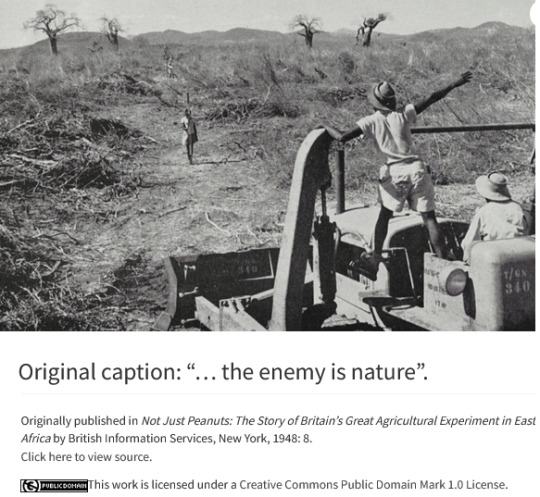
Officials sought to dismiss concerns that large-scale bush clearing would have wider environmental consequences, using the well-worn colonial trope that any observed changes in local climate or erosion patterns were due to the “primitive” agricultural practices of the locals, not to the earth-moving practices of the colonists.
Albert Walter, who had directed meteorology in East Africa since the 1920s, had been appointed as an advisor to the scheme and warned the other technical advisers of the low rainfall levels. [...] As the plants continued to wilt in the sun, Walter’s dense network of rain gauges made for an ideal field laboratory [...].
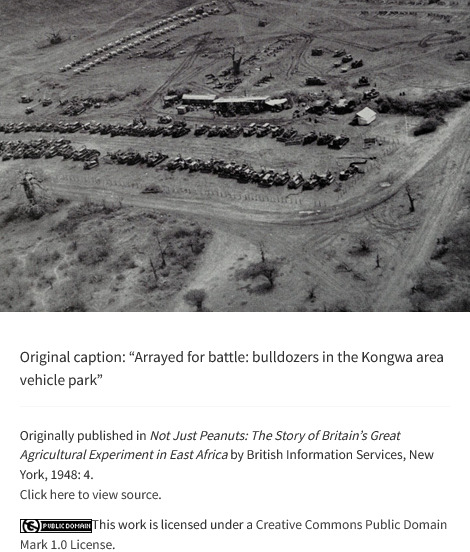
The stakes were high. As John Rosa of the Colonial Development Corporation put it in a letter: “Our standing as an Imperial power in Africa is to a substantial extent bound up with the future of this scheme. To abandon it would be a humiliating blow to our prestige everywhere.”
The only option left was to try and bend the weather itself to the scheme’s will, by seeding the clouds for rain. The scheme was nonetheless abandoned by the British government before charcoal burners could be lined up to seed clouds upwind of the growing area. But the experiments carried on under the aegis of the local colonial government and its meteorologists.
“Balloon bombs” (photographic film canisters tethered to weather balloons) and a repurposed Royal Navy flare gun were used to target individual clouds when the burners proved imprecise. [...] The rainmaking experiments lived on too, as a reference point for those who, to this day, seek to engineer the skies.
The scheme itself has survived as a cautionary tale of governmental hubris, but it is instructive too as a case study of how technologies of war have been turned against other foes.
---
All images, captions, and text by: Martin Mahony. “The Enemy is Nature: Military Machines and Technological Bricolage in Britain’s ‘Great Agricultural Experiment.’“ Environment and Society Portal, Arcadia no. 11. Rachel Carson Center for Environment and Society. Spring 2021. [Bold emphasis and some paragraph breaks/contractions added by me.]
91 notes
·
View notes
Text

The early signs of the now omnipresent polarization between farmers’ interests and environmental goals began to appear in the Netherlands in 2019.
That year saw both the launch of the European Green Deal as the EU’s overarching growth strategy and the establishment of a political party representing farmers’ interests in the Netherlands, the Farmer-Citizen Movement (BBB).
Five years later, the Green Deal has lost its appeal and the BBB is likely to enter government, although electorally the party seems past its peak.
Farmers are now protesting across Europe and many oppose, in particular, EU environmental policies they consider overly bureaucratic and damaging to their business.
The European Christian democrats (EPP) have clearly repositioned themselves as representatives of agricultural interests.
They are keen to keep the rural vote, which is also sensitive to other more conservative and right-wing issues.
In the Netherlands, this became clear in the most recent general elections where populist parties managed to attract a large part of the (rural) vote and where Geert Wilders’ anti-migration Freedom Party (PVV) became the biggest with about 25%.
Rebellion has been stirring in every corner of Europe against the European Green Deal, the legislative package designed to enable the European Union (EU) to comply with the Paris Agreement and limit emissions.
Polls have found that people are fed up with the restrictions associated with the environmental transition, and the right has been taking advantage of this discontent.
Farmers have taken to the streets to voice their exasperation with regulatory "norms coming from Brussels."
Now, what is the Green Deal, European Union (EU) Commission President Ursula von der Leyen stated it is a 90% CO2 emissions reduction target for the EU by 2040, compared to 1990 emissions levels.
This target clarifies the path that the EU's 27 member-states must take if they are to achieve carbon neutrality by 2050, having already committed to a 55% reduction in emissions by 2030.
In this respect, this target is decisive for the future of Europe's green transition, but won't make any impact globally as China, India and Africa won't be reducing their emissions.
Why are farmers angry?
The EU Green Deal requires farmers across the EU to make significant changes in how they work – from reducing their carbon footprints to adopting more sustainable practices, and selling their land.
The Dutch government specifically created a scheme to force farmers to sell their land or be branded criminals, as they created new legislation stating normal levels of nitrogen produced by livestock is now criminal.
In the scheme approved by the European Union's executive body, the Netherlands reserved the money to compensate farmers who "voluntarily" close their farms.
The scheme was to shut down 3000 highly productive farms, as the EU was treating them as they would industrial chemical plants, and a plan to take even more land in the future, 66% of the land in the Netherlands is used for agricultural practices.
Because of this the Netherlands generates 6% of the EU's food, despite only having 1% of the continent's farmland.
The Netherlands is the world's second-largest agricultural exporter, and has enough food to feed its population without trade.
The Netherlands also produces 4 million cows, 13 million pigs and 104 million chickens annually and is Europe's biggest meat exporter.
A nation cannot exist without agriculture, choosing to attack this industry is how you destroy nations, and cause famines, I don't care if you think I'm wrong @moreespressoformydepresso, I'm not.
29 notes
·
View notes
Text
Hachiko: The world's most loyal dog turns 100
2 July 2023

The Chinese tagline on the movie poster says it all: "I will wait for you, no matter how long it takes."
It tells the true story of Hachiko, the faithful dog that continued to wait for its master at a train station in Japan long after his death.
The cream white Akita Inu, born 100 years ago, has been memorialised in everything from books to movies to the cult science fiction sitcom Futurama.
And the Chinese iteration - the third after a Japanese version in 1987, and the Richard Gere-starrer in 2009 - is a hit at the box office.
There have been tales of other devoted hounds such as Greyfriars Bobby, but none with the global impact of Hachiko.
A bronze statue of him has stood outside Shibuya Station in Tokyo, where he waited in vain for a decade, since 1948.
The statue was first erected in 1934 before being recycled for the war effort during World War Two.
Japanese schoolchildren are taught the story of Chuken Hachiko - or loyal dog Hachiko - as an example of devotion and fidelity.
''Hachiko represents the ideal Japanese citizen with his unquestioning devotion," says Professor Christine Yano of the University of Hawaii - "loyal, reliable, obedient to a master, understanding, without relying upon rationality, their place in the larger scheme of things."
The story of Hachiko

Hachiko was born on 10 November 1923 in the city of Odate in Akita prefecture, the original home of Akitas.
A large-sized Japanese dog, the Akita is one of the country's oldest and most popular breeds.
Designated by the Japanese government as a national icon in 1931, they were once trained to hunt animals like wild boar and elk.
"Akita dogs are calm, sincere, intelligent, and brave [and] obedient to their masters," said Eietsu Sakuraba, author of an English language children's book about Hachiko.
"On the other hand, it also has a stubborn personality and is wary of anyone other than its master."
The year Hachiko was born, Hidesaburo Ueno, a renowned agricultural professor and a dog lover, asked a student to find him an Akita puppy.

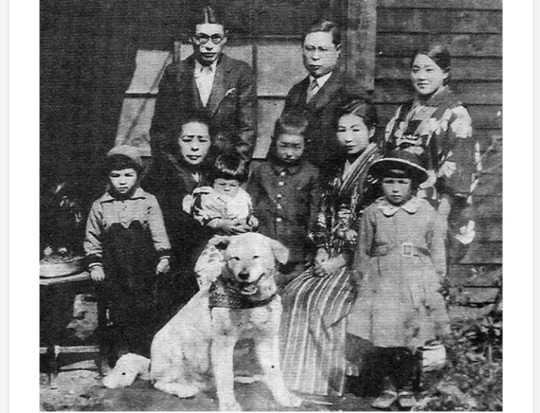
After a gruelling train journey, the puppy arrived at the Ueno residence in Shibuya district on 15 January 1924, where it was initially thought dead.
According to Hachiko's biographer, Prof Mayumi Itoh, Ueno and his wife Yae nursed him back to health over the next six months.
Ueno named him Hachi, or eight in Japanese. Ko is an honorific bestowed by Ueno's students.
The long wait

Ueno took a train to work several times a week. He was accompanied to Shibuya station by his three dogs, including Hachiko. The trio would then wait there for his return in the evening.
On 21 May 1925, Ueno, then 53, died of a cerebral hemorrhage. Hachiko had been with him for just 16 months.
"While people were attending the wake, Hachi smelled Dr Ueno from the house and went inside the living room. He crawled under the coffin and refused to move," writes Prof Itoh.
Hachiko spent the next few months with different families outside Shibuya but eventually, in the summer of 1925, he ended up with Ueno's gardener Kikusaburo Kobayashi.
Having returned to the area where his late master lived, Hachiko soon resumed his daily commute to the station, rain or shine.
"In the evening, Hachi stood on four legs at the ticket gate and looked at each passenger as if he were looking for someone," writes Prof Itoh.
Station employees initially saw him as a nuisance. Yakitori vendors would pour water on him and little boys bullied and hit him.
However, he gained nationwide fame after Japanese daily Tokyo Asahi Shimbun wrote about him in October 1932.
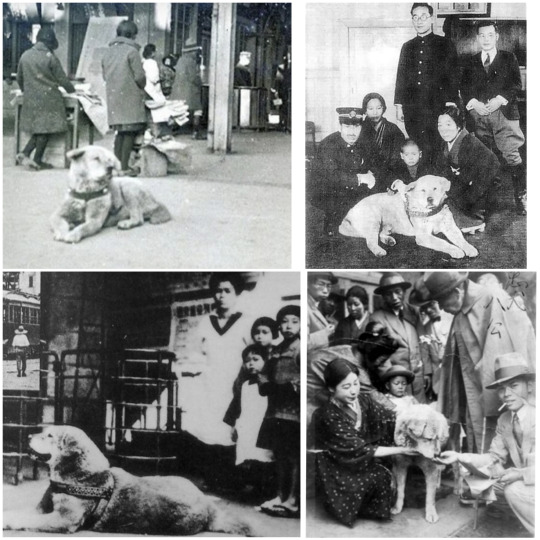
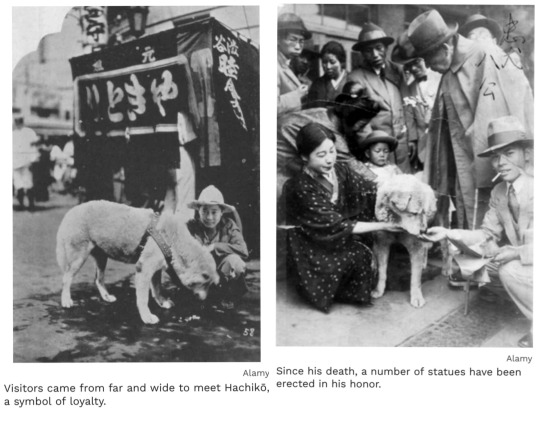
The station received donations of food for Hachiko each day, while visitors came from far and wide to see him.
Poems and haikus were written about him. A fundraising event in 1934 to make a statue of him reportedly drew a crowd of 3,000.
Hachiko's eventual death on 8 March 1935 at the age of 11 made the front page of many newspapers. He was found on a street in Shibuya.
In March 2011, scientists finally settled the cause of death of Hachikō: the dog had both terminal cancer and a filaria infection.
There were also four yakitori skewers in Hachikō's stomach, but the skewers did not damage his stomach nor cause his death.

At his funeral, Buddhist monks offered prayers for him and dignitaries read eulogies. Thousands visited his statue in the following days.
In impoverished post-war Japan, a fundraising drive for a new statue of Hachiko even managed to raise 800,000 yen, an enormous sum at the time, worth about 4bn yen (£22m; $28m) today.
"In retrospect, I feel that he knew that Dr Ueno would not come back, but he kept waiting - Hachiko taught us the value of keeping faith in someone," wrote Takeshi Okamoto in a newspaper article in 1982.
As a high school student, he had seen Hachiko at the station daily.
Remembering Hachiko
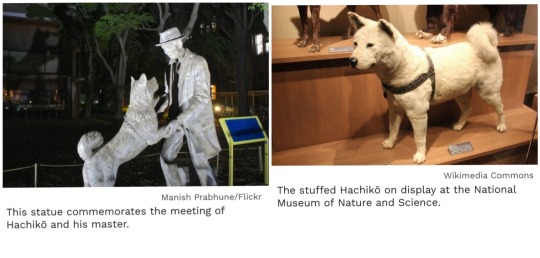
Every year on 8 April, a memorial service for Hachiko is held outside Shibuya Station.
His statue is often decorated with scarves, Santa hats and, most recently, a surgical mask.
His mount is on display at the National Museum of Nature and Science in Tokyo.
Some of his remains are interred at the Aoyama Cemetery, alongside Ueno and Yae.
Statues of him have also been cast in Odate, Ueno's hometown Hisai, the University of Tokyo and Rhode Island, the American setting for the 2009 movie.
Odate also has a series of events lined up this year for his 100th birthday.
Will the world's most loyal dog still be celebrated a century from now? Prof Yano says yes because she believes the "heroism of Hachiko" is not defined by any particular period - rather it is timeless.
Mr Sakuraba is equally optimistic.
"Even 100 years from now, this unconditional, devoted love will remain unchanged, and the story of Hachiko will live on forever."

🤍🐕🤍
#Hachiko#Akita Inu#Greyfriars Bobby#Shibuya Station#Tokyo#Japan#Chuken Hachiko#loyal dog Hachiko#dogs#animals#animal love#Akita prefecture#Odate#Hidesaburo Ueno#Tokyo Asahi Shimbun#Prof Mayumi Itoh#Kikusaburo Kobayashi#Takeshi Okamoto#April 8#National Museum of Nature and Science#Aoyama Cemetery#Akita#Hachiko @100#loyal dog
40 notes
·
View notes
Text
168 New Nazca Geoglyphs Discovered
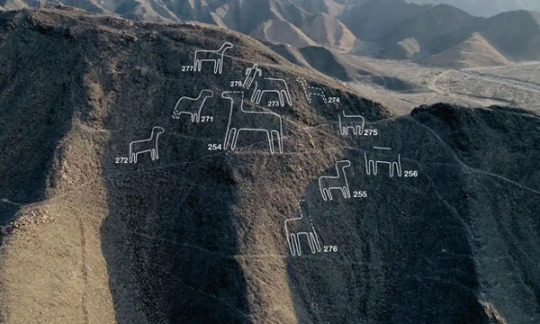
More than 100 new designs discovered in and around Peru's Nazca plain and surrounding areas could bring new information to light about the ancient artworks that have intrigued scientists and visitors for decades. Following two years of field surveys with aerial photos and drones, Peruvian and Japanese researches from Yamagata University reported the discovery of 168 new designs at the Unesco World Heritage site on Peru's southern Pacific coast.
The geoglyphs, huge figures carved into the South American desert, date back more than 2,000 years and depict living creatures, stylized plants and imaginary beings, as well as geometric figures several kilometres long. Jorge Olano, head archaeologist for the Nazca Lines research program, said the newly discovered figures averaged between 2 and 6 meters (6.56 to 19.7ft) in length.
The purpose of the Nazca Lines, which could only be seen from the air, remains a mystery. These new findings, however, are smaller and can be seen from the ground. The figures, iconic vestiges of Peru's rich history, are about a three-hour drive from the capital, Lima. Researchers had already discovered 190 figures in the area since 2004. But the vastness of the terrain they cover has complicated efforts to study and conserve the heritage site.
Yamagata University said the research will be used in artificial intelligence-based surveys to help inform the lines' preservation. Studies from the university in collaboration with Peru's government have helped delineate and protect the area, which is facing threats from urban and economic developments. Some geoglyphs are in danger of being destroyed due to the recent expansion of mining-related workshops in the archaeological park.
Anthropologists, ethnologists, and archaeologists have studied the ancient Nazca culture to try to determine the purpose of the lines and figures. One hypothesis is that the Nazca people created them to be seen by deities in the sky. Another theory is related to astronomy and cosmology, as has been common in monuments of other ancient cultures: the lines were intended to act as a kind of observatory, to point to the places on the distant horizon where the sun and other celestial bodies rose or set at the solstices.
Other theories were that the geometric lines could indicate water flow or irrigation schemes, or be a part of rituals to "summon" water. The spiders, birds, and plants may be fertility symbols. It also has been theorized that the lines could act as an astronomical calendar, as proved by the presence of radial centers aligned along the directions of winter solstice and equinox sunset. Researchers believe that the geoglyphs were the venues of events linked to the agriculture calendar. These also served to strengthen social cohesion among various groups of pilgrims, sharing common ancestors and religious beliefs.
8 notes
·
View notes
Text

Again asking for people to put Nur Masalha's Expulsion of the Palestinians: The Concept of "Transfer" in Zionist Political Thought, 1882–1948 (1992) in their reading list.
The amount of research that went into showing several trends of the plans that were drafted and dropped and revised in regards of planning what us Palestinians call the Nakba is so well done on Masalhas part because he captures how preoccupied zionists were with the palestinian question or in other words the pressing question of how to transfer the palestinian population. Their diaries, their recorded speeches in public, to the published articles, and memos to the UK and US government reveal how scientific they were about Palestinians. They thought of palestinians as movable as inanimate objects, essentially chattel. The argument between zionists wasn't whether the transfer was immoral or not but whether it should be done voluntarily or compulsory. Voluntary transfer was as ridiculous as it sounds but they were very detailed about how they would go about it. One plan was to give land to Palestinians in Jordan and the other to purchase land in Iraq:
“The Weizmann-Rutenberg scheme of 1930, which was presented to the Colonial Office, proposed that a loan of one million Palestinian pounds be raised from Jewish financial sources for the resettlement of Palestinian peasant communities in Transjordan, pending the granting of permission for Zionist settlement east of the Jordan River.”
. . .
“While Weizmann’s 1930 transfer proposals were rejected by the British government, the justifications used in their defense formed the cornerstone of subsequent argumentation for transfer. Yishuv leaders continued to assert that there was nothing “immoral” about the concept; that “the transfer of the Greek and Turkish populations provided a precedent for a similar measure for the Palestinian Arabs; and that the uprooting and transfer of the population to Transjordan, Iraq, or any other part of the Arab world would merely constitute a relocation from one Arab district to another.”
The Iraq "transfer" plan
Edward A. Norman (1900–1955) was a New York-based Jewish millionaire who devoted much of his fortune and his political activity to supporting the Yishuv. In 1939, he established the American Fund for Palestine Institutions (later to become the American-Israel Cultural Fund), as “the first agency for joint and unified fund-raising on behalf of the cultural institutions” of the Yishuv and later Israel.
. . .
In 1934, he worked out a detailed plan for the evacuation of Palestinian Arabs to Iraq which went through several versions before it was noticed as of late 1937. By early 1939, Norman’s plan had come to the attention of Weizmann, Ben-Gurion, and Shertok, who were in London during February and March for the St. James Conference. Weizmann, especially, made serious efforts to promote it.
The initial plan, a 19-page typewritten memorandum in English dated February 1934, was entitled “An Approach to the Arab Question in Palestine.” Its premise was that “immigration and possession of the land by definition are the basis of the reconstruction of the Jewish homeland.” At the same time, Norman acknowledged that Jewish colonization was a “genuine cause of concern” for the politicized Palestinian Arabs, since it entailed “taking over Palestine without the consent of the indigenous population.” Thus, the task facing the Yishuv was to ensure that “the Jews gradually are to fill up Palestine” while at the same time finding the Arab population a place to go, for “[the Arab population] cannot be exterminated, nor will it die out.”
He considered the “kingdom of Iraq” as a preferable destination “particularly [for] Arabs with agricultural experience,” and wanted the Iraqi government “to donate land and permit the importation of Arab farmers with their goods and chattels free of duty and visa fees.” Also “free transportation of persons, movable property, and livestock would have to be offered as well.” The collaboration of Arab political leaders and the Arab press would have to be obtained for this operation. Echoing earlier Zionist theories about the Palestinian character, he went on:
It must be remembered that a transportation such as suggested by Arabs from Palestine to Iraq would not be a removal to a foreign country. To the usual Arab there is no difference between Palestine, Iraq, or any other part of the Arab world. The boundaries that have been instituted since the War are scarcely known to many of the Arabs. The language, customs, and religion are the same.
. . .
The cost of settling a Palestinian family of six persons in Iraq was estimated at $300. Norman hoped that the indigenous population could be “bought out” and induced by economic rather than other means to evacuate Palestine.
#i knew the weizmann plan already#but i never really read these things in detail#its amazing how much they wrote#i dont mean to place palestine in a unique spotlight bc israeli tactics are the tactics of any settler nation but historians have pointed#out that the deliberate incessant planning was much more pronounced its so easy to look at their rhetoric and draw a straight line#of how they got from the first zionist council to the nakba#in 50 years#palestine
11 notes
·
View notes
Text
हरियाणा के किसानों को नई किस्मों और गुणवत्ता वाले बीज मुहैया करवाने के निर्देश
हरियाणा के किसानों को नई किस्मों और गुणवत्ता वाले बीज मुहैया करवाने के निर्देश
कृषि विभाग की समीक्षा बैठक में हरियाणा के कृषि मंत्री जेपी दलाल ने कहा कि बीज और फसल उत्पादन के बीच सीधा संबंध होता है. बीज की गुणवत्ता जितनी बेहतर होगी, फसल की पैदावार भी उतनी अधिक होगी और किसानों को फायदा होगा.
किसानों को उपलब्ध करवाए जाएंगे गुणवत्ता वाले बीज.
Image Credit source: File Photo
हरियाणा के कृषि एवं किसान कल्याण मंत्री जेपी दलाल ने अधिकारियों से कहा है कि वे किसानों को नई किस्मों…

View On WordPress
0 notes
Note
Mind summarizing the significance of this election to a stupid American like me?
Over the course of 4 years, bolsonaro have:
done a terrible job dealing with the pandemic, making fun of the dead, saying that he couldn't do anything, refused pfizer's offers to buy the vaccine early, pushed a untested scientifically unproven medicine for covid
turned a blind eye for illegal mining and the deforestation of the amazon rainforest, (deforestation raised by 56% in his government)
Helped approve several toxic chemicals for agriculture that are forbidden everywhere else
cut the budget of public colleges and scholarships, the public healthcare system also got a big cut, all to leave more money to buy support for his reelection,
Fired everyone who tried to investigate his schemes, bought 51 houses in actual cash
Put a secrecy of 100 years in his personal finances, his vaccine status and even the visits of his sons
Left pastors to decide who got what budget in the ministry of education
Let the value of the minimum wage to drop bellow inflation
Made several racist and homophobic remarks, even met with a literal neonazi leader
The science denial, antivaxx, anti-intelectual discourse, he shared a minimum of 4 fake news per day
It's so much, so much stuff, I know foreigners only care about the amazon, but the ppl are suffering, lots are starving, they are doing what they can to survive bc they have no jobs, prices of food and gas are increasing.
Edit: I found this tiktok that could help
43 notes
·
View notes